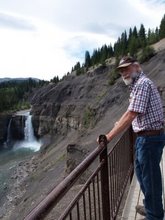On December 19, 2007 the CEO of TransCanada was asked whether he expected public opinion in Alberta to be against the construction of new facilities - potentially including a nuclear plant - that would produce power for export into the United States. "That kind of thinking is very short-sighted and ill-founded," he said.
The issues relating to the production of electricity from nuclear energy are complex and numerous, but to label the public’s concern as short-sightedness, in view of the frugal common sense of the average informed Albertan, these comments are condescending at best.
To promote the development of nuclear power, the industry claims that nearly 44 million kilowatt-hours of electricity can be produced from one tonne of uranium. In comparison, the same amount of electrical power produced from coal or natural gas requires the burning of over 20,000 tonnes of coal, or 8.5 million cubic metres of natural gas. This visibly pro-nuclear comparison is deceptively accurate, but it is definitely misleading if one considers that it takes approximately 20,000 tonnes of high-grade uranium ore to produce enough enriched uranium fuel to operate a 1000 MW nuclear power reactor each year. These comparisons may appear confusing, so the U.S. Nuclear Regulatory Commission (NRC) simplified the comparison and displays on its website that electricity produced from nuclear cost $30 per megawatt versus $29.10 per megawatt for coal. However the NRC study footnotes reveal that their nuclear reactor costs do not reflect federal subsidies, decommissioning costs, capital costs, waste containment costs, and transmission costs.
It should also be noted that the comparison is based on the availability of high-grade uranium ore, and the availability of this ore is a major concern for the industry as the world’s inventory is consumed. Presently the world’s inventory of high-grade ore sits at 5.5 million tonnes. This is expected to grow as exploration continues however, at the current rate of consumption (65,000 tonnes annually) the International Atomic Energy Agency and the Nuclear Energy Agency (IAEA-NEA) estimates that the world’s supply is expected to only last 200 years. Further, as the world consumes and depletes its inventory of the high-grade uranium ore, the number of tonnes of low-grade uranium ore required to produce 1-tonne of enriched fuel is expected to rise exponentially, forcing up the cost of electricity. Ironically, in anticipation of the depletion this inventory, research is underway to develop a process to extract uranium from coal ash. It is almost comical to think we would burn coal, to create ash, in order to extract uranium, so that we would not need to burn coal to produce electricity.
The economic business model supporting the development of nuclear power in Alberta is significantly flawed. On a cost per fuel basis the nuclear power industry has to deceptively manipulate the cost of uranium to even be in the same league as coal or natural gas. Add to that the associated costs of safety and environmental risks, and electricity produced from nuclear energy is completely uneconomical. In support of this finding, Bruce Power, the company proposing to build a nuclear power plant in Peace River has just announced they will need a subsidy from Alberta’s government before they can build a nuclear power plant.
Without even considering the environmental or safety issues (costs) associated with a nuclear power plant, it is economically inconceivable to build a nuclear power plant in Peace River unless the public subsidizes the project with tens of billions of dollars worth of transmission line infrastructure. In summary, if the private sector was required to build the infrastructure they would categorize such an investment as foolishly uneconomical! Why then does our government think this is a good investment for the public?
What should Albertans do when we have over 400 years worth of coal and over 200 years worth of natural gas (including shale gas) at our disposal? For a fraction of the $16.6 billion transmission line upgrades proposed by the Alberta Electric System Operator (AESO), Albertans should invest in transmission lines connecting Alberta to B.C. and Manitoba. Rather than building transmission lines from north to south (for export) to subsidize coal and nuclear generators, an east west transmission line policy would provide access to the abundant supply of cheap hydro-power, and provide western Canada with energy security. If we had a truly progressive government we could adopt an accelerated policy to decommission the coal generators and replace them with gas fired generators. Gas generators are cleaner burning and far more efficient than coal and nuclear because gas generators can actually be turned off when not in use. Nuclear and coal must run continuously whether or not the electricity is being used, creating a scenario whereby nearly 50% of all electricity produced is wasted.
A rapid transition to natural gas electricity generation, supplemented with the development of electric hydro power would stimulate Alberta’s economy, particularly the gas drilling sector. This could create thousands of jobs and catapult Alberta from being one of the worst emitters of CO2 to exceeding the Kyoto protocols on climate change. This in turn would reduce the need for carbon capture technology saving the public billions of tax dollars previously set aside for CCS. Add to this a feed-in-tariff policy for clean renewable energy and Alberta could find itself the world’s leader in the development of clean renewable energies in the matter of a few years.
In summary, Albertans need to stop asking what we should do, and starting acting on what we can do! It is time we lead by example!
Joe Anglin
Rimbey AB
(403) 843-3279
Subscribe to:
Post Comments (Atom)

No comments:
Post a Comment